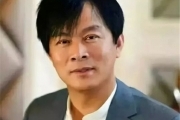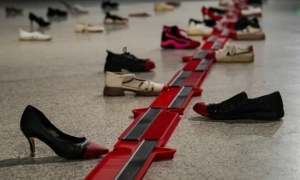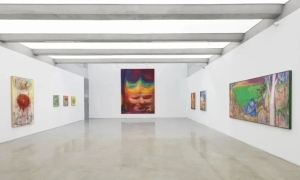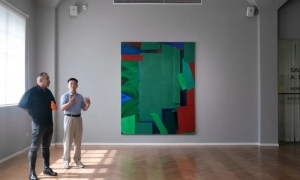展出由两部分组成: 绘画和影像
The exhibition combines two sections : painting and films
时间:2008年11月22日—12月14日
Time:11/22/2008-12/14/2008
地点:红三房画廊 北京朝阳酒仙桥路2号798艺术区
Address: Loft3 Gallery (B03 Building No.2 Jiuxianqiao Rd. Chaoyang District Beijing 100015 China)
自述
禅与革命ZEN & REVOLUTION,也是我90年代初在加拿大国家电视台艺术中心举办的第一次个人画展的题目。
禅来自梵文的Dhyana,英文译为ZEN,应该是英文里最能象征东方文化的符号。
禅的意思为静虑,安静而止息杂虑。
小时候我向邻居一位嗜酒如命的老国画家求学,除了学会静心研墨外,也偷阅了许多老先生珍藏的古代字画。那时就醉心于范宽、马远和倪云林。
在木板上起稿裱绢刷底用墨渲染再上油着色…… 20年前的《寺庙》系列可以说是在清静寂定的心境下画出来的。
革命是我记事之后最重要的一个词,做一个革命的艺术家是我童年时代的梦想,这个红色的梦想一直萦绕着我直到今天。我的电影作品《天安门上太阳升》、《他们选择了中国》都和革命的主题有关。
禅的艺术是自省的、逃避现实的。革命的艺术则是激情的、参与现实的。
二者都在我的血液里。
‘Zen & Revolution’ was also the title of my first solo exhibition at the Canada National Television Art Center in the early 90s.
‘Zen’ originally comes from the Sanskrit ‘Dhyana’, and is probably the one English word that most symbolizes Eastern culture.
Zen means meditation: seeking peacefulness in order to slow down and freely contemplate.
When I was young I went to learn from a neighbour – an experienced ink painter who was fond of drinking. Aside from learning the patience and how to paint with ink, I would also sneak a look at the old man’s collection of ancient calligraphy and paintings. At that time I was fascinated by Fan Kuan, Ma Yuan and Ni Yunlin.
On the wooden board I would first mount a silk base on which I used ink for the design, then I applied oil colours on top…you could say that the ‘Temple’ series of paintings which I painted 20 years ago were created in this kind of quiet and solitary state of mind.
For as long as I can remember, ‘revolution’ has been the word most important to me. To become a revolutionary artist was my childhood dream, and this dream has continued to affect me to this day. My films ‘Sunrise Over Tiananmen Square’ and ‘They Chose China’ both have connections with revolution.
The art of Zen is introspective and attempts an escape from reality. But the art of revolution is passionate and participates in reality.
Both of them are in my blood.
【编辑:霍春常】




























